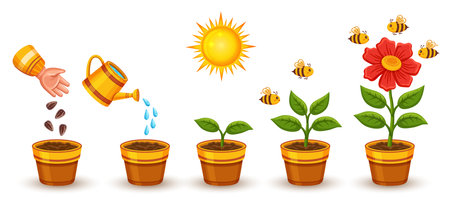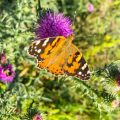Introduction to UK Butterfly Species
The United Kingdom is home to a remarkable diversity of butterfly species, each playing an important role in the country’s unique ecosystems. From the iconic Peacock and Red Admiral, often spotted fluttering through gardens in summer, to rarer species such as the Swallowtail and Large Blue, British butterflies offer both beauty and ecological value. These insects are more than just a delight for gardeners; they serve as vital pollinators and as indicators of environmental health. While some species are widespread and can be seen from spring through early autumn, others have limited distributions and are highly sensitive to changes in habitat and climate. Recognising the seasonal patterns of these butterflies—such as the early emergence of the Brimstone in March or the late appearances of Speckled Wood—can help gardeners make informed decisions to support their local populations. Creating a butterfly-friendly garden begins with understanding which species are present in your region, appreciating their ecological significance, and recognising how your outdoor space can contribute to their survival.
2. Choosing the Right Plants for Butterfly Attraction
Creating a butterfly-friendly garden in the UK begins with careful selection of native plants that cater to both adult butterflies and their larvae. The right mix of nectar-rich flowers and larval food plants will ensure your garden provides nourishment throughout the butterfly life cycle, from egg to adult. Prioritising species that thrive in UK soils is essential for low-maintenance gardening and long-term success.
Nectar-Rich Plants for Continuous Blooms
Butterflies are particularly attracted to brightly coloured, fragrant flowers with accessible nectar. To guarantee blooms from early spring to late autumn, choose a variety of plant species with staggered flowering times. Here’s a seasonal guide to popular UK-native nectar sources:
| Season | Nectar Plant | Notable Butterfly Visitors |
|---|---|---|
| Spring | Cowslip (Primula veris) Bluebell (Hyacinthoides non-scripta) |
Orange-tip, Peacock |
| Summer | Buddleja (Buddleja davidii) Knapweed (Centaurea nigra) Field Scabious (Knautia arvensis) |
Red Admiral, Painted Lady, Small Tortoiseshell |
| Autumn | Ivy (Hedera helix) Aster (Aster novi-belgii) |
Comma, Speckled Wood, Small Copper |
Larval Food Plants: Supporting the Full Life Cycle
A truly butterfly-friendly garden must also offer food plants for caterpillars. Butterflies are highly selective when it comes to laying eggs; each species relies on specific host plants for their larvae to feed on. Incorporating these into your planting scheme encourages breeding and sustains local populations. Key examples include:
| Butterfly Species | Larval Food Plant(s) | Where to Grow in Garden |
|---|---|---|
| Small Tortoiseshell & Peacock | Nettle (Urtica dioica) | Sunny corner or wild patch, away from main beds |
| Common Blue | Bird’s-foot Trefoil (Lotus corniculatus) Clover (Trifolium repens) |
Lawn edges or wildflower meadow areas |
| Large White & Small White (Cabbage Whites) | Cabbage family plants (Brassica spp.) Nasturtium (Tropaeolum majus) |
Vegetable patch or ornamental borders |
| Speckled Wood | Mosses and grasses (varied species) | Dappled shade under trees or hedgerows |
Cultivation Tips for UK Conditions
Select well-drained soil types and consider your garden’s sunlight exposure. Native species tend to be resilient against local pests and diseases. Grouping plants together creates larger ‘target’ patches, making them more visible to butterflies flying overhead. Regular deadheading of spent blooms will encourage prolonged flowering, offering a continuous supply of nectar.
Sustainable Sourcing Matters
Whenever possible, purchase seeds or young plants from reputable nurseries specialising in British native flora. Avoid cultivars bred solely for showy appearance as these may lack the vital pollen and nectar that butterflies need.
This thoughtful approach to planting ensures your garden remains an essential resource for butterflies year after year, supporting not just fleeting visits but complete life cycles within your green space.
![]()
3. Creating Suitable Habitats and Shelter
Designing a butterfly-friendly garden in the UK requires thoughtful consideration of diverse microhabitats to support every stage of a butterfly’s life cycle. Incorporating a range of features will not only attract more species but also ensure their ongoing survival throughout the changing British seasons.
Sunny Spots for Basking
Butterflies are cold-blooded creatures that rely on warmth from the sun to become active. When planning your garden, prioritise open, south-facing areas that receive plenty of direct sunlight. Place flat stones or stepping slabs in these locations, as they provide ideal basking spots for butterflies to warm themselves on cooler mornings.
Sheltered Corners Against the Elements
Wind can be detrimental to butterflies, making it difficult for them to feed or rest. To create effective shelter, use existing walls, fences, or hedges as windbreaks. Alternatively, plant dense shrubs such as hawthorn, holly, or privet along the boundaries of your garden. These natural barriers offer protection from strong winds and heavy rain—typical features of the British climate—while providing essential resting places.
Establishing Hedgerows and Wild Borders
Hedgerows serve as vital corridors and breeding grounds for many native butterfly species. Incorporate mixed native hedging—such as blackthorn, dog rose, and elder—to supply both nectar and larval food sources. Allow some sections of your borders to grow wild with grasses and nettles; these untidy patches are invaluable for caterpillars and overwintering chrysalises.
Layered Planting for Diverse Microhabitats
A successful butterfly garden includes plants at different heights and densities. Combine tall perennials with low-growing ground covers to provide a rich tapestry of habitats. This layered approach caters to species with varying needs and encourages greater biodiversity overall.
Additional Tips for UK Gardens
Leave piles of logs or stones undisturbed in quiet corners—these offer shelter during adverse weather and hibernation sites for adult butterflies over winter. Avoid over-tidying: a slightly ‘wilder’ approach helps preserve natural refuges that butterflies depend upon throughout their lifecycle.
4. Sustainable Garden Practices for Wildlife
Creating a butterfly-friendly garden in the UK requires more than simply planting nectar-rich flowers. Embracing sustainable gardening practices is vital to nurturing butterflies and other pollinators, ensuring their habitats remain safe and healthy for future generations. The following recommendations focus on minimising pesticide use, promoting organic methods, and maintaining water sources as part of an integrated approach to wildlife-friendly gardening.
Minimising Pesticide Use
Pesticides can be highly detrimental to butterflies at all life stages, from caterpillar to adult. To foster a safe environment:
- Avoid chemical pesticides and herbicides: Opt for natural alternatives such as neem oil or hand-picking pests where practical.
- Encourage natural predators: Attract birds, ladybirds, and hedgehogs, which help control pest populations naturally.
- Spot treat only when necessary: If intervention is required, apply solutions directly to affected areas rather than blanket spraying the whole garden.
Promoting Organic Gardening
Organic gardening not only benefits butterflies but also supports a healthier overall ecosystem. Consider the following best practices:
| Practice | Description |
|---|---|
| Composting | Create nutrient-rich soil by composting kitchen and garden waste, reducing reliance on synthetic fertilisers. |
| Crop rotation | Prevent soil depletion and control pests by rotating plant families each season. |
| Mulching | Suppress weeds naturally and retain soil moisture with organic mulches such as bark chips or leaf mould. |
Maintaining Water Sources for Pollinators
A reliable water source is essential for butterflies and other pollinators, especially during dry spells. Simple additions can make your garden a haven:
- Shallow dishes or birdbaths: Place pebbles in shallow containers so butterflies can safely land and drink without risk of drowning.
- Puddling stations: Create damp patches with mud or sand that provide minerals and salts vital for butterfly health.
- Pond maintenance: If you have a pond, avoid using algaecides or chemicals. Ensure gentle slopes for easy access by wildlife.
The Benefits of Sustainable Practices
Sustainable gardening helps maintain balance within your local ecosystem. By making thoughtful choices, you’ll not only attract butterflies but also encourage bees, hoverflies, and beneficial insects. These actions contribute to a resilient and thriving UK wildlife community right on your doorstep.
5. Seasonal Maintenance and Monitoring
Year-Round Upkeep for a Thriving Butterfly Habitat
Maintaining a butterfly-friendly garden in the UK requires seasonal attention to ensure your outdoor space remains an inviting sanctuary for butterflies throughout the year. Spring is the ideal time to clear away dead plant material while leaving some leaf litter and hollow stems for overwintering insects. In summer, focus on deadheading flowers to encourage continuous blooming and provide nectar-rich options for adult butterflies. During autumn, allow seed heads to remain as both a food source and shelter, and avoid cutting back all perennials. Come winter, limit tidying activities; undisturbed areas offer vital protection for pupae and eggs against cold snaps.
Observing Butterfly Activity: What to Look For
Regular observation is key to understanding which species are visiting your garden and how they interact with your chosen plants. Set aside time to walk through your garden during warm, sunny days—peak butterfly activity usually occurs between late morning and early afternoon. Make note of feeding preferences, mating behaviours, or caterpillar presence on host plants. Observing these patterns can help you refine your planting choices and maintenance routines, ensuring your garden meets the needs of local butterfly populations.
Recording Sightings: Supporting Local Conservation
Your observations can play a vital role in national conservation initiatives. The UK boasts several citizen science projects such as Butterfly Conservation’s Big Butterfly Count and local biodiversity recording schemes. Keep a simple logbook or use dedicated apps to record dates, weather conditions, and species spotted in your garden. Sharing this data helps researchers monitor population trends, identify at-risk species, and inform future conservation efforts. By contributing your records, you support broader efforts to protect Britain’s butterflies for generations to come.
6. Engaging with UK Butterfly Conservation Initiatives
Supporting butterfly populations in your garden extends beyond planting and habitat management—it also involves active participation in broader conservation efforts across the UK. Numerous national organisations, citizen science projects, and community events are dedicated to protecting Britain’s butterflies, offering a variety of ways for individuals to contribute and connect with like-minded enthusiasts.
National Organisations Championing Butterflies
The foremost organisation for butterfly conservation in the UK is Butterfly Conservation, which leads research, advocacy, and practical initiatives nationwide. Membership provides access to expert advice, regular newsletters, local branch activities, and opportunities to volunteer on habitat management projects. Other key groups include the Royal Society for the Protection of Birds (RSPB) and the Wildlife Trusts, both of which run dedicated programmes for pollinator-friendly gardening and species monitoring.
Citizen Science: Monitoring and Recording
Citizen science plays a crucial role in tracking butterfly populations and informing conservation priorities. The Big Butterfly Count, held annually each summer, invites people across Britain to count butterflies in gardens, parks, and green spaces for fifteen minutes. Data collected helps scientists understand trends and identify species at risk. Additionally, ongoing recording schemes such as the UK Butterfly Monitoring Scheme welcome volunteers to submit sightings throughout the year via user-friendly apps or online portals.
How to Get Involved:
- Register for the Big Butterfly Count and encourage friends, family, or schools to join.
- Submit regular sightings through the iRecord Butterflies app or Butterfly Conservation’s website.
- Participate in training workshops hosted by local branches to improve identification skills.
Community Events and Local Action
Across the UK, communities organise events that raise awareness about butterfly conservation and foster collective action. Look out for guided butterfly walks, garden open days focused on wildlife-friendly practices, and seasonal fairs featuring talks from experts. Many councils support wildflower planting campaigns on public land; getting involved can extend your impact beyond your own garden. Joining a local nature group or “Friends of” park association can further amplify your contribution.
The Lasting Impact of Engagement
By engaging with these initiatives—whether through hands-on volunteering, data collection, or community advocacy—you help build a resilient network of habitats and ensure that butterflies continue to flourish across Britain’s landscapes. These collective efforts not only benefit butterflies but enrich local biodiversity and connect people with the natural world in meaningful ways.


